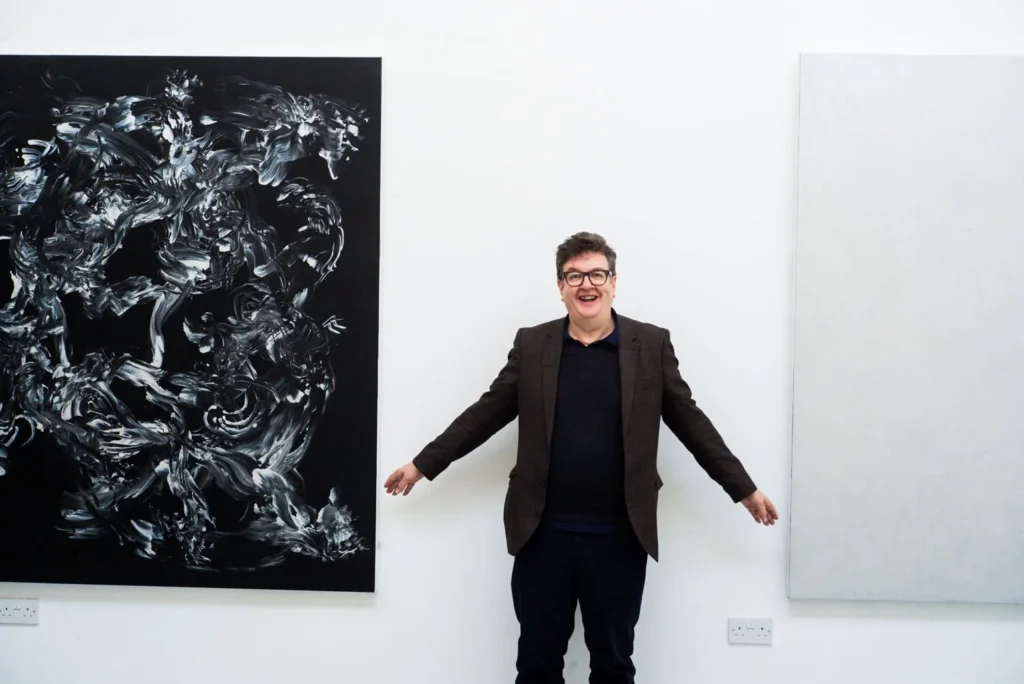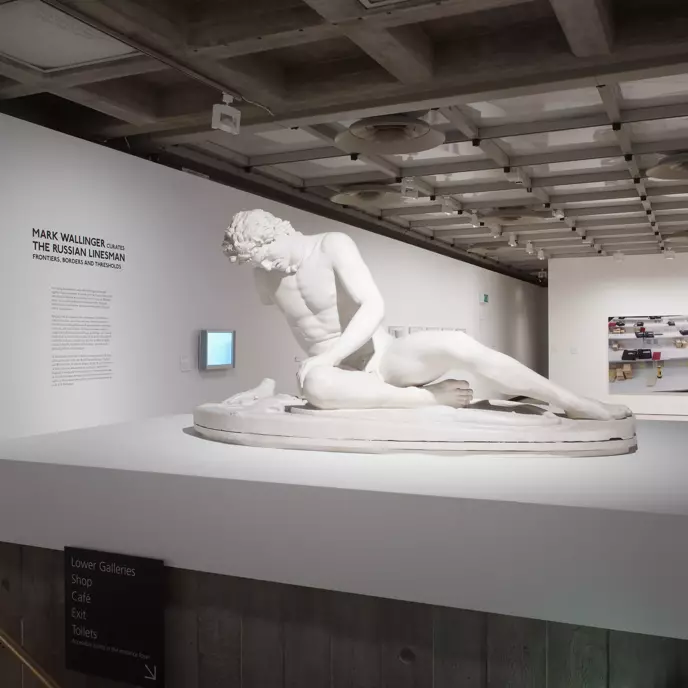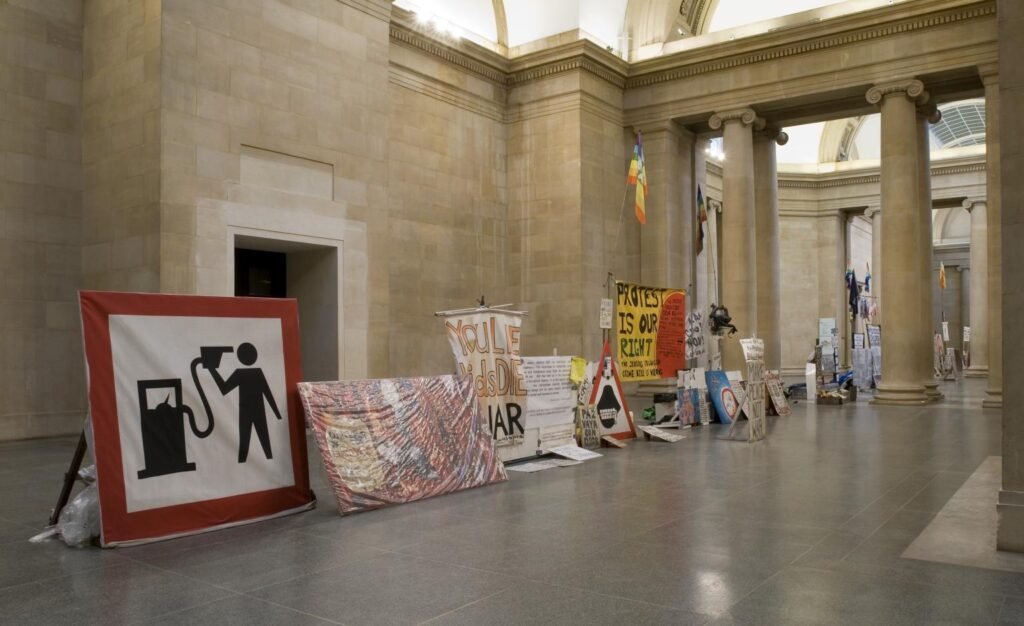Memoriesforart » Artists » Mark Wallinger
More Facts
Name: Mark Wallinger
Surname: Wallinger
Lives & Works: Chigwell
Lives in State: South East
Nationality: England
Date of Birth: 1959
Period: Post-War
Movement: Young British Artist
Table of Contents

Mark Wallinger was born in Chigwell, Essex, England in 1959. He grew up in a middle-class family and had an ordinary upbringing. His earliest interest in art manifested at a young age. Wallinger attended a grammar school where he first studied art. He went on to pursue a Foundation Course at the Chelsea School of Art from 1978 to 1979 and then earned his Bachelor of Arts degree in fine art at Goldsmiths, University of London, from 1979 to 1982.
During his formative years as an art student, Wallinger was exposed to conceptual and postmodern art. His work was influenced by these styles, as evidenced in his early paintings and assemblages. After graduating, Wallinger began gaining recognition for his thought-provoking and politically-charged pieces.
In the late 1980s, Wallinger started incorporating performance, film, and video into his artistic practice. His work became more conceptual, often containing pop culture references and appropriation.
Wallinger’s early life, education, and formative experiences as an artist shaped his distinctive socially conscious style. His politically engaged and thought-provoking pieces would come to define his influential career. Wallinger’s diverse work has made him one of Britain’s most renowned contemporary artists.

Mark Wallinger is known for producing conceptually diverse and multi-disciplinary works that explore themes of identity, faith, and politics. His art utilizes a variety of styles and mediums to provoke thought on the human experience.
Wallinger frequently blurs the boundaries between conceptual and literal meanings in his diverse video installations, sculptures, paintings, and public works. His politically charged and intellectually imaginative pieces have established him as a renowned and thought-provoking contemporary British artist with an influential if controversial, creative vision.

Wallinger’s early works were influenced by conceptual art of the 1970s, especially artists like Marcel Broodthaers, who explored semiotics and the relationship between language, meaning, and visual representation. Wallinger’s early installations incorporated found objects and appropriated images to question models and reality.
|
The British flag |
1990 |
One of Wallinger’s first notable works was The British Flag, where he photographed a British flag printed onto a mirror, creating an endless reflection within the flag’s pattern. This clever trick draws the viewer’s attention to themes of nationalism and identity that Wallinger would continue to explore. |
|
Angel |
1990 |
Wallinger dressed as an angel and wandered the streets of London, exploring notions of faith and spiritual experience in contemporary society. Photographs and videos of these performances were later exhibited. |
|
Time machine |
1991 |
The Time Machine incorporated mirrors and video monitors in a maze-like installation, presenting the viewer with fractured images of themselves in a way that evokes concepts of temporality, consciousness, and the human psyche. |
These early works demonstrated Wallinger’s unique interdisciplinary approach, merging performance, photography, video, and sculpture. They also highlight major themes in his oeuvre, like British identity, religion, and perception. Wallinger’s skillful use of appropriation, reflection, and parody in these works to probe complex ideas cemented his place as an influential figure in the Young British Artists movement.
Wallinger frequently incorporates Christian religious symbolism and mythology in his work. For example, his 2001 sculpture Ecce Homo depicts a life-size figure of Jesus Christ before his crucifixion, crowned with barbed wire. The work challenges viewers to reflect on spirituality and suffering. Similarly, Wallinger’s Via Dolorosa stations of the cross invite observers to embark on a symbolic journey reflecting on Christ’s passion.
Much of Wallinger’s art also examines notions of national identity and patriotism. His work State Britain recreated peace campaigner Brian Haw’s protest in Parliament Square. In contrast, A Real Work of Art incorporated a racehorse named Work of Art in a sly critique of the art market and English cultural heritage. Wallinger was also the first artist to officially represent England at the Venice Biennale, appropriating the iconic symbol of Britannia for his work.

Some of Mark Wallinger’s most notable pieces are his breakthrough works from the 1990s that brought him mainstream recognition. Among these influential works are:
|
Ecce Homo |
1999 |
Ecce Homo, one of Wallinger’s most well-known pieces, is a life-size statue of Jesus Christ before his crucifixion. The sculpture is a hyperrealistic depiction of a tortured human form that evokes empathy and raw emotion in viewers. This controversial piece earned Wallinger the Turner Prize in 1999 and established him as an artist known for politically and spiritually charged works. |
|
A Real Work of Art |
1994 |
A Real Work of Art was Wallinger’s first major public commission. He placed a racing horse in a glass box in London’s Euston Square Gardens for this piece. This peculiar installation highlighted themes of spectacle and voyeurism that Wallinger would continue to explore in his later works. The jarring sight of the horse outside its usual context and confined in a transparent box provoked questions about humanity’s relationship to and dominance over the natural world. |
|
Threshold to the Kingdom |
1999 |
It is a video installation featuring a lone figure dressed as a bear in a corridor at the Millennium Dome. As the figure paces silently back and forth, its ominous presence creates a surreal and thought-provoking atmosphere. This work is characteristic of Wallinger’s ability to turn ordinary objects and events into profound artistic statements about existence, spirituality, and the human condition. |
Mark Wallinger continues to create thought-provoking art that provides commentary on contemporary issues. His current projects demonstrate his ongoing impact and the enduring legacy of his work.
|
2007 |
State Britain |
This large-scale installation featured a recreation of peace campaigner Brian Haw’s Parliament Square protest site. It highlighted freedom of speech issues and the relationship between the state and the individual. The work was met with critical acclaim and cemented Wallinger’s status as a seminal contemporary artist. |
|
2016 |
Constructed World |
This solo exhibition at Nottingham Contemporary surveyed Wallinger’s diverse practice over three decades. It included paintings, sculptures, films, and installations that explore constructed realities and interrogate notions of Britishness. Reviewers praised the show for demonstrating Wallinger’s ” acute observations of the human condition.” |
|
2017 |
National Trust |
Wallinger was the first contemporary artist appointed by the National Trust to respond to their collection and properties. His contributions include site-specific works at Hanbury Hall and the Wordsworth Museum. This opportunity has allowed Wallinger to engage with English heritage and history thoughtfully. Critics argue this body of work represents some of his “most poetic and poignant” art. |
Through these pioneering works, Wallinger established himself as a leading contemporary British artist known for politically engaged and philosophically meditative pieces across various media, including sculpture, painting, photography, and film. His artwork has brought him acclaim and inspired essential conversations about society, politics, and spirituality.
Instagram: https://www.instagram.com/mark_wallinger_mark/
Twitter: https://twitter.com/MarkWallinger3
LinkedIn: https://www.linkedin.com/in/mark-wallinger